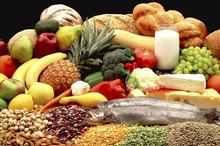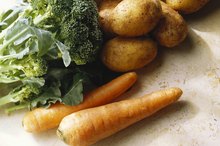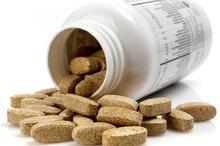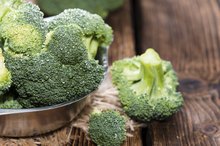The Symptoms of Manganese Deficiency
Manganese is a trace mineral that plays an important role in numerous biological processes throughout the body. It is nutritionally essential only in small amounts, yet manganese is vital to life. Manganese is available in various foods, nevertheless according to the University of Maryland Medical Center, it is estimated that as many as 37 percent of Americans do not meet the recommended daily intake for this mineral. Low levels of manganese in the body can cause a variety of health complications.
Function
The human body contains approximately 15 to 20 mg of manganese, which is primarily found in the bones, liver, kidney, pancreas, adrenal and pituitary glands. It helps the body form connective tissue, blood clotting factors and sex hormones. (Reference 1) It is functions as a cofactor to antioxidants and is necessary for the metabolism of carbohydrates, fat, amino acids and cholesterol. It plays a role in calcium absorption, blood sugar regulation, bone health, wound healing and proper brain and nerve function.
- The human body contains approximately 15 to 20 mg of manganese, which is primarily found in the bones, liver, kidney, pancreas, adrenal and pituitary glands.
Adequate Intake Level
Iron & Potassium
Learn More
The Food and Nutrition Board at the Institute of Medicine established an adequate intake level for manganese. These requirements vary by age and gender. Teenage boys ages 14 to 18 need 2.2 mg and teenage girls ages 14 to 18 require 1.6 mg of manganese each day. Men over the age of 19 require 2.3 mg and women older than 19 require 1.8 mg of manganese per day. Pregnant women need 2.0 mg and breast-feeding women need 2.6 mg of manganese daily. Your dietary intake of manganese and supplemental manganese should not exceed 10 mg per day due to the risk of nervous system side effects.
- The Food and Nutrition Board at the Institute of Medicine established an adequate intake level for manganese.
- Men over the age of 19 require 2.3 mg and women older than 19 require 1.8 mg of manganese per day.
Manganese Deficiency
Although a number of Americans do not consume an adequate amount of manganese, a true deficiency of this mineral is considered rare. A deficiency typically occurs only if manganese is eliminated from the diet. The most common cause of low manganese levels is a poor dietary intake. Other factors include malabsorption, antacid or oral contraceptive use that interfere with its absorption, excessive sweating because large amounts of manganese is lost in sweating, excess iron, copper or magnesium because they deplete manganese, and chronic liver or gallbladder disorders, which raise intake requirements.
- Although a number of Americans do not consume an adequate amount of manganese, a true deficiency of this mineral is considered rare.
Deficiency Symptoms
Low-Magnesium Diet
Learn More
Manganese is involved in many different biochemical processes and can, therefore, adversely affect a number of systems throughout the body. Low levels of manganese in the body can result in impaired glucose tolerance, altered carbohydrate and fat metabolism, skeletal abnormalities, bone demineralization and malformation, stunted growth, decreased serum cholesterol levels, skin rash and elevated blood calcium, phosphorus and alkaline phosphatase levels. In addition, manganese deficiencies can result in infertility, seizures, weakness, nausea or vomiting, dizziness, hearing loss, iron-deficiency anemia, weak hair and nails and convulsions, blindness or paralysis in infants.
Food Sources
Foods rich in manganese include fruits such as pineapple, grapes, kiwi and berries; vegetables like dark leafy greens, beets, sweet potatoes, celery, squash and carrots; nuts and seeds; legumes; soy products like tofu and tempeh; egg yolks; whole grains such as brown rice, oatmeal, raisin bran, quinoa, barley and spelt; herbs and spices like peppermint, cinnamon, cloves and thyme; molasses; syrup and tea. The estimated average dietary manganese intakes range from 2.1 to 2.3 mg per day for men and 1.6 to 1.8 mg per day for women.
Foods That Inhibit Manganese
Foods that contain phytic acid, such as beans, seeds, nuts, whole grains and soy products, or foods high in oxalic acid, such as cabbage, sweet potatoes, and cabbage, can moderately inhibit manganese absorption. Cooking these foods may help neutralize this effect. While tea is a good source of manganese, the tannins present in tea may slightly reduce its absorption. Additionally, the intake of other minerals, including phosphorus, calcium and iron, has been found to limit the body’s ability to retain manganese.
- Foods that contain phytic acid, such as beans, seeds, nuts, whole grains and soy products, or foods high in oxalic acid, such as cabbage, sweet potatoes, and cabbage, can moderately inhibit manganese absorption.
- Additionally, the intake of other minerals, including phosphorus, calcium and iron, has been found to limit the body’s ability to retain manganese.
Related Articles
References
- Linus Pauling Institute; Manganese; Jane Higdon, Ph.D.; March 2010
- Higdon J, Drake VJ. Manganese. Oregon State University. Linus Pauling Institute Micronutrient Information Center. Updated March 2010.
- Health and Medicine Division of National Academies of Sciences, Engineering, and Medicine. In: Otten JJ, Hellwig JP, Meyers LD, editors. Dietary Reference Intakes: The Essential Guide to Nutrient Requirements. Washington, DC: The National Academies Press; 2006: 350-355.
- MedlinePlus. Manganese. Updated March 16, 2020.
- National Institutes of Health. Dietary Supplements: What You Need to Know. Updated April 7, 2020.
Writer Bio
Erica Wickham covers health, exercise and lifestyle topics for various websites. She completed an internship in dietetics and earned a Master of Science in dietetics from D’Youville College in Buffalo, N.Y. Wickham now serves as a registered dietitian.








